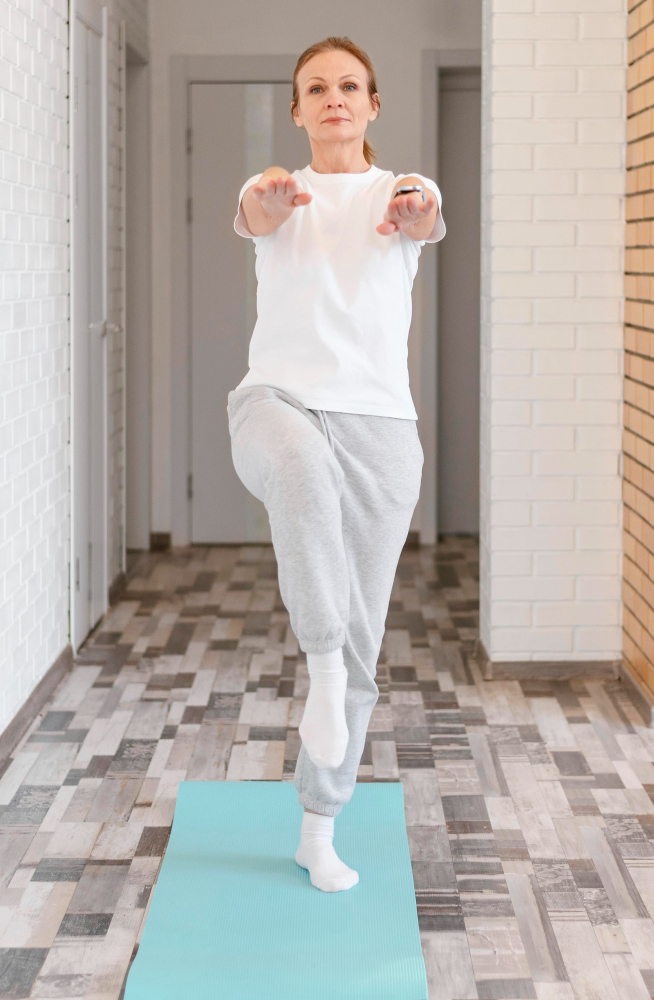Table of Contents
Introduction
Yoga is a powerful tool for maintaining health and wellness, especially in the later years of life. Standing yoga poses, in particular, offer a range of benefits for seniors, from improving balance and flexibility to enhancing mental focus. This article explores several key standing poses ideal for older adults and provides tips on practicing them safely.
Standing Yoga Poses
Standing yoga poses are a fundamental aspect of yoga practice that focuses on improving balance, strength, and flexibility. Here are some popular standing yoga poses, along with their benefits:
- Mountain Pose (Tadasana): This pose is often used as a starting position for other standing poses. It helps improve posture, balance, and calm focus.
- Tree Pose (Vrikshasana): This pose helps strengthen your thighs, calves, ankles, and spine while improving balance and stability. It also aids in increasing the flexibility of the hips and inner thighs.
- Warrior I (Virabhadrasana I): This pose stretches the chest and lungs, shoulders and neck, belly, and groins. It also strengthens the shoulders, arms, and back muscles and strengthens and stretches the thighs, calves, and ankles.
- Warrior II (Virabhadrasana II): This pose increases stamina and endurance in your legs and core while stretching the hips, groin, and shoulders. It also helps improve balance and concentration.
- Extended Triangle Pose (Utthita Trikonasana): It stretches and strengthens the thighs, knees, and ankles; stretches the hips, groins, hamstrings, and calves; shoulders, chest, and spine.
- Chair Pose (Utkatasana): This strengthening pose targets the muscles in the thighs and feet while toning the core and lower back.
- Extended Side Angle Pose (Utthita Parsvakonasana): This pose helps stretch the sides of the body, legs, and hips and strengthens the leg muscles. It’s beneficial for increasing stamina and endurance.
These poses enhance physical flexibility and strength and bring mental calmness and focus. Incorporating these poses into a regular yoga practice can significantly improve overall health and well-being.
Benefits of Standing Yoga Poses
Standing yoga poses offer a wide range of benefits that extend beyond simple physical improvements. They are essential for building a solid foundation in any yoga practice. Here are some key benefits of standing yoga poses:
- Enhanced Strength and Stability: Standing poses engage major muscle groups, particularly in the legs and core, leading to increased strength. The reliance on balance and posture in these poses also develops core stability, which is vital for overall movement efficiency and injury prevention.
- Improved Flexibility and Mobility: These poses often involve stretching multiple muscle groups, including the hamstrings, hips, back, and shoulders. Regular practice can improve overall flexibility and mobility, contributing to better joint health and range of motion.
- Better Balance and Coordination: Standing yoga challenges your balance in various positions, helping enhance your proprioception (sense of body position) and coordination. This can be especially beneficial as it translates into improved agility and prevention of falls.
- Increased Circulation: Standing poses help to stimulate blood flow throughout the body. Improved circulation contributes to the better oxygenation of tissues and removes toxins, promoting healthier organ function and boosting energy levels.
- Stress Reduction and Mental Clarity: Yoga can effectively relieve stress, like many forms of physical exercise. Standing poses require focus and concentration, which can help clear the mind of distracting thoughts and reduce stress. The meditative aspect of maintaining poses can lead to enhanced mental clarity and calmness.
- Promotion of Weight Loss: These poses can be surprisingly physical and help burn calories. When practiced regularly, standing yoga can contribute to weight management and be integrated into a sequence that includes faster pacing or transition between poses.
- Enhanced Body Awareness: Regular practice of standing yoga poses helps increase awareness of your own body—how it moves, where it holds tension, and how it feels in different positions. This heightened awareness can improve alignment in and out of the yoga studio, leading to better posture and reduced bodily pain.
Incorporating standing yoga poses into your routine can thus contribute to both physical and mental well-being, making it a valuable practice for people of all ages and fitness levels.
How to Get Started
Starting yoga can be as simple as setting up a quiet, comfortable space at home and using basic props like yoga mats and straps to aid balance and flexibility. Consider reading Creating a Yoga Practice: A Comprehensive Guide for a comprehensive approach to creating your yoga routine.
FAQs
Which Type of Yoga is Best for Seniors?
For seniors, particularly those just starting with yoga or those with limited mobility, the following types of yoga are highly recommended:
Hatha Yoga: This type involves a slower pace with more static pose holding. It helps in building strength and flexibility at a gentle pace.
Hatha Yoga: A Comprehensive Guide to Mind-Body Wellness
Iyengar Yoga: Known for its use of props like blocks, straps, and chairs, Iyengar Yoga helps seniors achieve the correct alignment in each pose safely, which is ideal for those with physical limitations.
Chair Yoga: As the name suggests, Chair Yoga is practiced sitting on a chair or using it for support. It’s particularly beneficial for those who have difficulty standing or balancing.
Restorative Yoga: This type focuses on relaxation and restoration with the use of props to support the body fully in each pose, allowing muscles to relax deeply. It’s very gentle and can be beneficial for those recovering from injury or illness.
How to Start Yoga at Age 70?
Consult a Doctor: Before starting any new exercise regimen, it’s important to consult with a healthcare provider, especially to understand any limitations or precautions.
Find a Suitable Class: Look for yoga classes labeled as “senior,” “gentle,” “beginners,” or classes that specifically mention being suitable for all ages. Many community centers, senior centers, and yoga studios offer classes tailored to older adults.
Begin Slowly: Start with foundational poses and gradually increase difficulty as flexibility, strength, and confidence improve.
Use Props: Don’t hesitate to use props like blocks, straps, and chairs to help maintain balance and alignment.
Listen to Your Body: Avoid pushing into painful movements; yoga should not hurt. Focus on your own progress and abilities rather than comparing yourself to others.
Is 75 Too Old to Start Yoga?
No, 75 is not too old to start yoga! Many people begin yoga later in life and experience significant benefits. The key is to tailor the practice to your current fitness level and health concerns.
Is Yoga Good for Over 70?
Absolutely. Yoga is beneficial for those over 70 for several reasons:
Improves Balance: Reducing the risk of falls, which can be a serious concern in old age.
Increases Flexibility and Mobility: Helps maintain joint health and ease movement.
Builds Strength: Essential for maintaining independence in daily activities.
Promotes Mental Health: Can alleviate symptoms of depression and anxiety, often improving overall mood.
Enhances Respiratory Function: Gentle breathing exercises in yoga can improve lung capacity.
Enhances Respiratory Function: Gentle breathing exercises in yoga can improve lung capacity.
Conclusion
Standing yoga poses are a valuable activity for seniors. They offer both physical and mental benefits that can significantly enhance their quality of life. For more yoga poses tailored to seniors, explore the Top 10 Yoga Poses for Seniors to Improve Balance and Stability.







